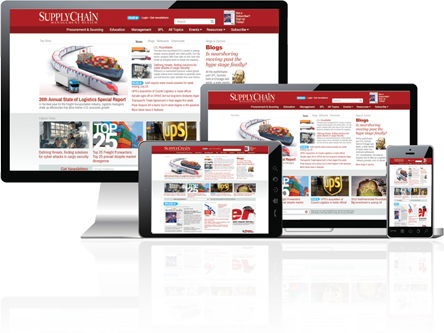Infrastructure Fix Requires Innovating Our Regulatory Approach
The real problem with infrastructure is the management process – or lack thereof.
Latest News
Supply Chain Services acquires Dasco Label Automated storage and retrieval system (ASRS) market worth $10.7 billion by 2025 Trucking comeback: Dohrn Transfer turns the corner with assist from Pitt Ohio JSCM Video: Managing buyer-supplier conflicts JSCM Video: Managing buyer-supplier conflicts More NewsLatest Resource
Simplifying Your End-to-End Supply Chain Download this report highlighting each point on the supply chain journey by explaining the role it plays, which includes the pain points you may face, what you should be thinking about at a particular stage in the journey, and what technology you can benefit from.
Download this report highlighting each point on the supply chain journey by explaining the role it plays, which includes the pain points you may face, what you should be thinking about at a particular stage in the journey, and what technology you can benefit from.
All Resources
There are early signs that there might finally be some movement toward addressing infrastructure investment in this country. Yet even in the best case – that funding is fixed in the next few months – infrastructure won’t improve anytime soon.
The real problem with infrastructure is the management process – or lack thereof. Consider the fact that half of infrastructure spending goes to administrative costs, including fighting legal challenges. Most of the legal costs result from environmental groups, despite the heavy obligation to conduct environmental assessments for every infrastructure project, and the fact that few things could be worse for the environment than out-of-date infrastructure. Other countries with better environmental reputations such as Germany have figured out how to streamline the process of project approvals to a year or two, versus the eight to twelve years it often takes in the U.S. We need to emulate them.
There is also the gas tax – long used as a political football. Increasing fuel efficiency and decreasing per capita driven miles mean less tax revenue. Some politicians refuse to raise the tax on principle, ignoring the fact that deteriorating roads actually cost Americans more in the form of increased costs for product to reach market, increased insurance costs and taxes to repair cars damaged by potholes and poor infrastructure, lost time and increased pollution from congestion, and increased emissions and inconvenience to communities from traffic re-routed due to sub-standard infrastructure. Whether your car is an antiquated gas guzzler or an electric environmental wonder, it requires a safe and efficient road system. We should consider a gas tax that adjusts for average miles per gallon and miles driven, based on actual usage data—information that’s been tracked for decades.
Especially worrisome is the fact that infrastructure for utilities and communications tends to follow transportation infrastructure, so the health of one influences the health of the other, and together, that’s a huge impact on efficiency. In an era of increasing dependence on digital interconnectedness, failure to invest in transportation infrastructure will lead to atrophy of competitiveness in general. This is not just competitiveness in terms of economics or business profits – this is atrophy in healthy quality of life as a deteriorating infrastructure is bad for the environment, bad for our health, and bad for our social well-being.
The United States is a special case in some ways – our population is spread out in suburbs, making us more road-dependent than most other developed countries. We were one of the first to develop public policy and regulations for modern infrastructure. After almost 70 years, it is time to re-invigorate our spirit of innovation, and develop entirely new approaches to managing our infrastructure development and maintenance process.

About the Author
 Michael Gravier
Michael Gravier is a Professor of Marketing and Supply Chain Management at Bryant University with a focus on logistics, supply chain management and strategy and international trade. Follow Bryant University on Facebook and Twitter.
Michael Gravier
Michael Gravier is a Professor of Marketing and Supply Chain Management at Bryant University with a focus on logistics, supply chain management and strategy and international trade. Follow Bryant University on Facebook and Twitter.

Subscribe to Supply Chain Management Review Magazine!
Subscribe today. Don't Miss Out!Get in-depth coverage from industry experts with proven techniques for cutting supply chain costs and case studies in supply chain best practices.
Start Your Subscription Today!
 Simplifying Your End-to-End Supply Chain
Download this report highlighting each point on the supply chain journey by explaining the role it plays, which includes the pain points you may face, what you should be thinking about at a particular stage in the journey, and what technology you can benefit from.
Download Today!
Simplifying Your End-to-End Supply Chain
Download this report highlighting each point on the supply chain journey by explaining the role it plays, which includes the pain points you may face, what you should be thinking about at a particular stage in the journey, and what technology you can benefit from.
Download Today!
 When COVID-19 was bringing other supply chains to a screeching halt, AGCO acted early and decisively to keep its operations around the world up and running. The key: A very agile supply chain.
When COVID-19 was bringing other supply chains to a screeching halt, AGCO acted early and decisively to keep its operations around the world up and running. The key: A very agile supply chain.
Supply Chain Management is not enough Risk Management in an Era of Extreme Uncertainty View More From this Issue
 Master Your Supply Chain with an Intelligent Control Tower
Today’s control towers provide powerful capabilities and real-time responsiveness with Autonomous Problem-Solving, Global Demand-Supply Matching and Global Available-to-Promise.
Register Today!
Master Your Supply Chain with an Intelligent Control Tower
Today’s control towers provide powerful capabilities and real-time responsiveness with Autonomous Problem-Solving, Global Demand-Supply Matching and Global Available-to-Promise.
Register Today!











